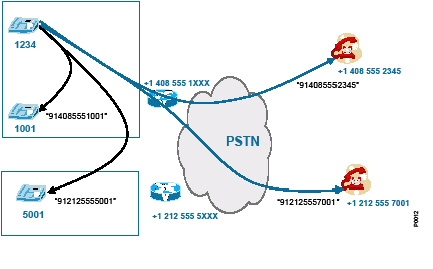Preventing Unnecessary Toll Charges
Question
In a Cisco Unified Communications Manager design where +E.164 destinations are populated in directory entries, which call routing practice is critical to prevent unnecessary toll charges caused by internal calls routed through the PSTN?
Answers
Explanations
Click on the arrows to vote for the correct answer
A. B. C. D. E.A.
Forced On-Net Routing - It is not uncommon for the dialing habits for on-net/inter-site and off-net destinations to use the same addressing structure.
In this case the call control decides whether the addressed endpoint, user, or application is on-net or off-net based on the dialed address, and will treat the call as on-net or off-net, respectively.
Figure 14-4 shows an example of this forced on-net routing.
All four calls in this example are dialed as 91 plus 10 digits.
But while the calls to +1 408 555 2345 and +1 212 555 7000 are really routed as off-net calls through the PSTN gateway, the other two calls are routed as on-net calls because the call control identifies the ultimate destinations as on-net destinations.
Forced on-net routing clearly shows that the dialing habit used does not necessarily also determine how a call is routed.
In this example, some calls are routed as on-net calls even though the used PSTN dialing habit seems to indicate that an off-net destination is called.
Figure 14-4 Forced On-Net Routing -

Forced on-net routing is especially important if dialing of +E.164 destinations from directories is implemented.
In a normalized directory, all destinations are defined as +E.164 numbers, regardless of whether the person that the number is associated with is internal or external.
In this case forced on-net routing is a mandatory requirement to avoid charges caused by internal calls routed through the PSTN.
http://www.cisco.com/c/en/us/td/docs/voice_ip_comm/cucm/srnd/collab09/clb09/dialplan.htmlIn a Cisco Unified Communications Manager (CUCM) design where +E.164 destinations are populated in directory entries, it is critical to prevent unnecessary toll charges caused by internal calls routed through the PSTN. This can be achieved through the implementation of "forced on-net routing" practice.
Forced on-net routing is a call routing method that ensures that all calls between internal users on the same CUCM cluster are routed directly through the IP network, rather than being sent through the PSTN. This method is achieved by configuring a specific route pattern that matches the internal dial plan and specifying the "Route This Pattern" setting to use the "On-Net" option.
By implementing forced on-net routing, internal calls between users on the same CUCM cluster will be routed directly through the IP network, resulting in cost savings and improved call quality. This method also ensures that the +E.164 numbers populated in the directory are used only for external calls, preventing unnecessary toll charges.
Automated alternate routing is a call routing method used to provide redundancy and failover in case of network outages or congestion. Forced authorization codes and client matter codes are used for call billing and accounting purposes and are not directly related to preventing unnecessary toll charges caused by internal calls routed through the PSTN. Tail-end hop-off is a feature used in VoIP service provider networks and is not relevant to CUCM design.
Therefore, the correct answer to the question is A. forced on-net routing.
